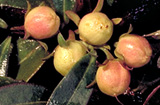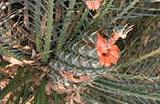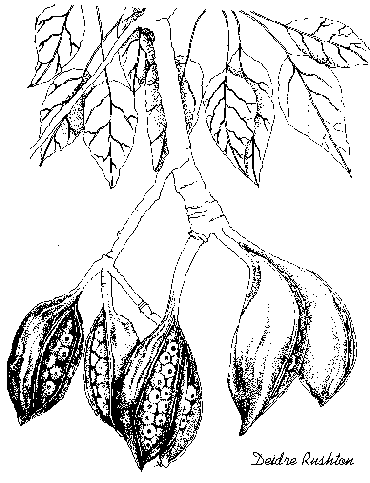|
[Front Page] [Features] [Departments] [SGAP Home Page] [Subscribe]

Spreading the Genes
Peter Vaughan
For a plant, life is not what it seems. Days are not spent in an idyllic immobility, basking in the sun watching visiting birds and mammals. No.....before you all go off and convert to Buddhism hoping to reincarnate as plants, think of the other things. Not only are there thunder storms, dark nights, bird droppings and even fire - there is competition.
Competition rules the lives and forms of our plants. They compete for nutrients, water, light, space and pollinators. Although not directly related, the seed dispersal mechanism is directly linked to competition. Plants that cannot efficiently disperse their seeds just won't spread, and given time will probably disappear.
For those who do not consider seed dispersal to be a competitive feature, think about the following mechanisms.
What'll the ants do to help?
Ants and wattles have a close relationship. In Australia, our wattles, or acacias, produce small black seeds held in the seed pod by a specialised stalk called an aril. The aril contains protein and being quite nutritious is collected by ants as a food source. As the ants can only utilise the aril they dump the seed, often at the next rubbish heap. This is actually a designated area containing other waste matter that, when broken down, supplies nutrients to the seedling. Some seeds are also left inside the nest. Others outside are covered deeply by years of accumulated rubbish. Consequently, when a bushfire passes through, the wattle seeds do not feel the full effect of the heat. Wattles grow better after the hottest bushfires; the smaller bushfires favouring different plant groups.
 
The messages from this: Firstly, we need all types of bushfires, and secondly, if looking for wattle seeds, look around ant nests.
The arils have a distinctive length and form for each species. Acacia melanoxylon has a large aril that is brightly coloured. The very similar species A.implexa has a much smaller cream coloured aril. Obviously their seeds are dispersed in different ways which is why they do not usually grow together.
Pop goes the seed.
A common seed dispersal mechanism is the high speed ejection of the seed from the pod. This is usually caused by the drying and contraction of the pod, resulting in a build up of forces that are suddenly released. This mode is best observed on the hottest day in summer. I have seen wattle seeds (A.cultriformis) thrown two metres by this method and I have felt Viola betonicifolia seeds strike me, such is the force they travel with. Although a widespread dispersal mechanism, it must take a long time for a plant species to travel from one valley to the next relying on this method.
Fire
Banksias, eucalypts and many other Australian plants hold their seeds until fire kills the branch or parent plant, allowing the capsules to open and seeds to be dispersed. However, once the seed is released it is wind transported. There is a big advantage of wind distribution after fire, as large areas have been cleared and now invite recolonisation. There is a rush to get out and cover the land. Another consideration is that not all banksias and eucalypts hold their seed waiting for fires. For example, Banksia integrifolia and Eucalyptus melanoxylon release their seed once ripe. This is considered a primitive feature and the other species are actually more suited to their environment, maximising opportunities as they arise.
 |
The seed follicles on this cone of Banksia oblongifolia have opened following a fire to release the seeds.
Select the thumbnail image or plant name for a higher resolution image (48k).
|
To be eaten or not to be eaten
Many plants produce edible fruits with seeds capable of remaining viable after passing through a bird's digestive system. This is a straight forward point. However when the first European settlers arrived they found plants that produced fruits which birds ate, but the seed was beside the flesh, not inside. Thus the early settlers claimed our plants fruited inside out! The plants in point are the Podocarpus sp. (native pines) and Exocarpus sp. The latter are in the mistletoe family but grow in the ground and parasitise on plant roots. Their seed dispersal mechanism requires the bird to pick the fruit off the stem, fly to an adjacent tree, eat the flesh and then wipe it's beak on a branch, knocking the seed to the ground.
This method has an advantage over the eaten seed, as the seed coat does not have to be reinforced to withstand the bird's stomach. Also the eaten part, the fruit, can be smaller and so can be eaten by a wider range of birds. The disadvantage is in the fact that the seed is dropped to the ground soon after removal from the plant, and would not travel the distances that a seed might if it spent an hour or two inside a bird.
Other seeds are eaten by birds as the bird digests and utilises the fleshy covering. Examples of this are Mistletoe species, Pigeonberry Ash (Elaeocarpus kirtonii), Eremophila sp. (called Emu bushes for this reason) and many, many others. When I am collecting rainforest seeds in North Queensland I always look for Cassowary droppings (not too fresh), and collect the many seeds held within.
 |
The fleshy fruits of Eremophila debilis.
Select the thumbnail image or plant name for a higher resolution image (30k).
|
Some birds have a nomadic lifestyle, following fruiting trees. The topknot pigeon (a rainforest bird, not the common crested pigeon, a ground feeding bird) wanders up and down the Australian east coast feeding on Pigeonberry Ash (thus the name), Lillypillys, Bangalow palms, figs and many others. As a method of seed dispersal between rainforest patches, these birds are ideal. They spend little time out of rainforests and travel extensively.
Such nomadism is not restricted to rainforests as emus travel continually following the fruiting of eremophilas and nitre bush (Nitraria billardieri). Seeds of many other plants will not germinate unless eaten by birds. So if you want to grow eremophilas from seed, you must first "catch your emu." Perhaps we can overcome these germination problems by feeding the seeds to turkeys. Can someone please try it?
To help the chances of staying alive while passing through the bird's digestive tract, many seeds have rapid trips. The desert dwelling nitre bush, when consumed in large quantities, upsets the emus gastro-intestinal tract, giving the emu the 'trots'. Consequently the emu has to eat more seeds to obtain sufficient nutrients, something they donít mind doing, and the seeds are spread, fairly evenly, wherever the emu 'trots'.
Missed the Boat
Mistletoe is a plant restricted in its distribution by its seed dispersal mechanism. The mistletoe bird has a very close relationship with mistletoes. The mistletoe berry is its main source of food and the mistletoe clump is its nesting site. The bird has even developed a specialised gastro-intestinal tract for dealing with mistletoe seeds. The tract is fairly even in form and allows the seed to pass through in as short a time as 25 minutes. Thus the bird can eat many seeds, obtaining more nutrients, and the plant has more seeds dispersed.
However, mistletoe is not found in Tasmania. Mistletoe birds are occasionally blown across Bass Straight, or fly of their own accord but they are unable to do this in the half hour or so the seeds stay in their bodies. Hence they lose their precious cargo on the way, or to put it another way, they throw away their future to lighten their load.
Another bird that eats mistletoe seeds is the silver eye. Not being as specialised, silver eyes retain the seeds for much longer, so that they could transport the seeds across Bass Straight. Also silver eyes migrate each spring from many points on the mainland across to Tasmania. However, they do not carry the seeds across into Tasmania because mistletoes are not fruiting during the migration period. There are simply no fruits to carry across.
Colour
Colour is an important indication to bird dispersal. Red berries are almost certainly dispersed by birds. Typical of these are the Lillypillys. The tree violet (Hymenanthera dentata), with its purple berries, is another plant which is very popular with the smaller birds for its fruits.
Not all seed dispersal mechanisms are obvious. What spreads the seeds of bunya pines (Araucaria bidwillii) and cycads?
 |
The seeds of this cycad Macrozamia communis occur in large cones and drop to the ground when ripe.
Select the thumbnail image or plant name for a higher resolution image (40k).
|
Bunya pine and the cycads both have very large fruits, (about the size of a large football), which are very heavy. No native animal is a specialised feeder of these fruits although one native rat does eat bunya seeds. The native rodents have not been in Australia long enough to shape the evolution of these plants. Perhaps this animal stored seeds for periods of shortage. Whatever the method, the animal is no longer assisting the plant and the bunya pine is now only a relic of its former self. Isolated stands occur in South East Queensland (Bunya Mountains National Park, Kondabilla National Park near Noosa) and two isolated stands in North East Queensland (Atherton Tablelands and Port Douglas). The population must have been continuous at one time but it shrunk, probably during a dry period in Australia's past. When the better times returned the bunya pine was unable to come out from its refuges as other plants could. Consequently the bunya pines are now rare plants.
This pattern is also reflected in the cycad family and seven species are endangered. These plants now have effective seed dispersal downhill only.
 
Kurrajongs have me puzzled. How are their seeds dispersed? They evolved prior to the arrival of Aboriginals in Australia. Their seeds are quite edible to animals and birds with strong beaks. However, the seeds are covered by many small, irritating bristles in the pod. They are also destroyed if eaten by animal or bird. Is there an animal that stores their seed, which is produced abundantly? Perhaps by the end of winter there are a few seeds stored that are not consumed and allowed to germinate?
I think this may be the reason as the seeds are bright yellow. The plant wants something to find its seeds. Amazingly though, 5-10% of the seeds are not yellow but are black. Thus something looking for yellow seeds misses these and they may germinate where they fall. This is safety, having a seed both ways. Perhaps the original corn plants had their seeds dispersed the same way.
Peter Vaughan is very interested in the total environment. He has had a keen interest in Australian native plants plants over many years and has written numerous articles for a range of publications. Living in the Hunter Region of NSW, he does not grow Western Australian species but concentrates on east coast species that bring the ecosystem to his garden. He is currently studying ornithology at Charles Sturt University.
This article is reprinted from the Winter 1984 issue of "Hawkesbury Flora" published by the Hawkesbury Group of the Society for Growing Australian Plants.

[Front Page] [Features] [Departments] [SGAP Home Page] [Subscribe]
Australian Plants online - June 1999
Association of Societies for Growing Australian Plants
|